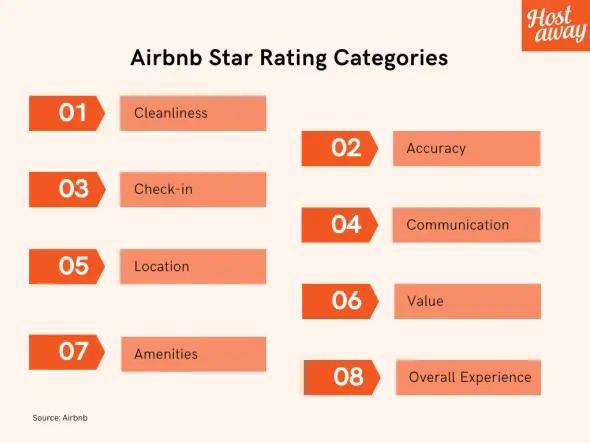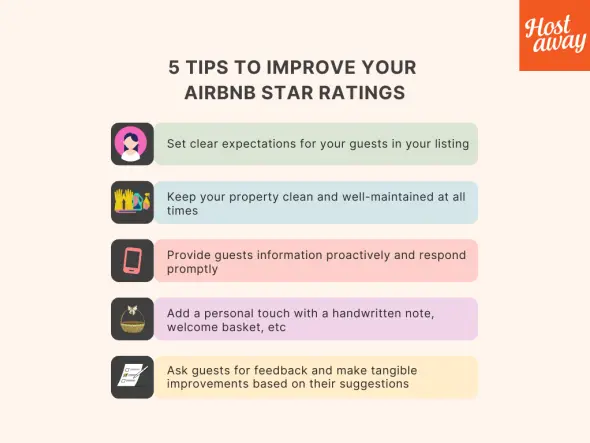How Airbnb Star Ratings Can Make or Break Your Vacation Rental Business
%20(1).webp?u=https%3A%2F%2Fimages.ctfassets.net%2Fpqmtoyw9z10u%2F4dM60coEd5jzkCHUOyifrz%2Fa95cb31b3ad5853de3b291d289da3fb3%2FDALL_E_2024-10-22_10.41.10_-_A_beautiful_Airbnb_vacation_rental_located_in_a_serene_environment._The_house_features_a_moder.webp&a=w%3D960%26h%3D549%26fm%3Dwebp%26q%3D75&cd=2024-10-22T10%3A12%3A27.276Z)
Star ratings on Airbnb are a critical metric that significantly influences a listing’s success. For potential guests, they serve as a quick indicator of quality and reliability, helping them decide which property to choose. For hosts, maintaining a high rating means more visibility, higher rankings in search results, and ultimately, greater revenue.
This article explores how Airbnb star ratings work, how different rating levels impact hosts differently and provides strategies for maintaining strong ratings.

What Are Airbnb Star Ratings?
With over 7.7 million listings on the platform, picking the right property to stay in can feel arduous. Airbnb star ratings and reviews are designed to help guests do just that, filtering through the chaff to offer them a list of properties known for their reliability and guest experience.
According to BnB Facts, the distribution of ratings on Airbnb is heavily skewed toward the higher end, with 96% of listings having a rating of at least 4 stars and 86% of listings having a rating of 4.5 or higher.
Meanwhile, a GitHub analysis of Airbnb listings showed that more experienced hosts got higher ratings, that entire homes and private rooms had better ratings than shared rooms and premium properties like castles and chalets rated better than budget properties like campers and dorms.
How Do Airbnb Star Ratings Work?
Airbnb allows guests to share their experience of each stay through reviews and ratings — measured on a scale of 1 to 5 stars. Over 371 million reviews have been left by guests on the platform, impacting future guests' decision to stay at a property.
Guests can rate their stay across eight categories, between 1 and 5 stars. The categories are:
Cleanliness: Did it meet Airbnb’s standards for cleanliness?
Accuracy: Was the listing information and photographs an accurate representation?
Check-in: Was the check-in process easy?
Communication: Did the Airbnb host respond to messages promptly and satisfactorily?
Location: Were there any safety, transportation, noise or other considerations that affected the guest’s stay and were they made aware of them prior to booking?
Value: Was the experience worth the price?
Amenities: Were the amenities listed in good condition and working well?
Overall experience: How was it overall? This is a specific category that guests rate and not an average of the ratings of the other categories
Airbnb also allows guests to further select options after they’ve chosen a rating. If a guest selects a positive rating — 4 or 5 stars — for Check-in, for example, they are also presented options to choose what they specifically liked, such as ‘Easy to find’ or ‘Personal welcome’.
On the other hand, if a guest selects a negative rating — 3 stars or less — they will be given options for what they did not like. Using the same example, they would be presented options like ‘Hard to locate’ or ��‘Unclear instructions’.

The Impact of High vs. Low Ratings on Airbnb Listings
Higher ratings lead to greater growth. That’s an accepted axiom. A McKinsey study shows that even small changes in star ratings can drive explosive growth but the order on which that happens depends on the category.
Airbnb’s review system works similarly. Listings with higher ratings enjoy prime placement in search results and tend to attract more bookings and command higher rates with the biggest rewards concentrated at the very top. Properties with 5-star ratings often experience a positive feedback loop—higher bookings lead to more reviews, which further enhance the listing’s credibility and visibility.
Let’s look at the impact of star ratings on Airbnb listings.
Highest ratings (4.9 - 5 stars)
In 2023, according to AirDNA data, Airbnb listings with an average rating of 4.9 stars or above experienced a higher average daily rate (7.7%), occupancy rate (9.7%) and revenue (18.2%) than their counterparts.
Hosts also need to have an average rating above 4.9 stars to make the cut for selection to Guest Favorites. The listings are rewarded with a Guest Favorites badge in search results, and guests can filter for Guest Favorites in search. Since November 2023, 13.5 million stays have been booked in Guest Favorite homes.
High ratings (4.8 – 4.9 stars)
Listings with an average rating of 4.8 or above can qualify for Superhost status, which is associated with increased trust and can result in 22% more bookings. The designation, which comes with its own badge, improves visibility on Airbnb search, increases perceived trustworthiness and provides promotional opportunities to hosts.
In fact, nearly two-thirds of Guest Favourites come from Superhosts.
Mid ratings (4 - 4.7 stars)
Airbnb listings in this range are considered good but might not stand out among fierce competition. In fact, AirDNA’s 2023 data shows that 88% of reviews of properties in the U.S. were 5 stars, meaning these hosts risk losing out to competitors consistently achieving higher scores. To remain competitive, they need to review their ratings, find out what they are doing wrong and make rapid improvements.
Low ratings (3 stars or less)
Guests are unlikely to book low-rated listings unless they are heavily discounted, leading to lower occupancy rates and profits. Properties with ratings below 4 stars are also penalized with lower search rankings and can even be removed from the platform.
Airbnb now shows guests if a property is in the bottom 10% of listings based on ratings, reviews and reliability and since April 2023 has removed 100,000 listings including those that continue to provide a below-par experience for guests. Airbnb is also building new tools to prevent these properties from being relisted on the platform.
Hosts with low-rated listings must address their issues immediately and elevate their overall experience.
How to Check Your Star Ratings on Airbnb
Click Today and then click Menu
Click Insights
Click Reviews
Or, if you have professional hosting tools, go to Performance and click Quality

How to Improve Your Airbnb Star Ratings: 5 Tips
1. Set clear expectations
One of the primary reasons for low ratings on Airbnb is when the reality doesn’t match the guest’s expectations. Setting clear expectations ensures that guests know exactly what they’re signing up for, reducing the risk of negative reviews.
Actionable tip: Make sure your photos are up-to-date and accurately represent the space. If the couch has been replaced or the wall color changed, update the listing immediately.
Example: Instead of using broad terms like “close to downtown,” specify the exact distance or travel time: “A 10-minute walk to Main Street.” For properties near noisy areas, disclose this in a positive way: “Experience the vibrant nightlife, with music from the local bars filtering in until 11 PM.”
2. Maintain top-notch cleanliness
Cleanliness is one of the top factors that influence guest ratings. Guests are likely to leave a 5-star rating if they feel that the property was immaculately clean and well-kept.
Actionable tip: Use a cleaning checklist for every turnover, covering high-touch areas like door handles, light switches and remote controls. Hire a professional cleaner if needed, especially for deep cleaning tasks.
Example: Leave a small handwritten note saying that every surface has been sanitized and provide a mini bottle of sanitizer as a welcome gift.
3. Enhance communication
Quick and effective communication is essential for providing a smooth experience for guests. This includes promptly answering questions before and during the stay and being proactive in providing information.
Actionable tip: Use automation tools like scheduled messages to send check-in instructions, local recommendations and check-out reminders. Personalize these messages by adding the guest’s name.
Example: Send a welcome message when the guest checks in and include local restaurant recommendations. Even though it’s automated, tailor the recommendations based on the guest’s profile and preferences.
4. Provide a personal touch
Going the extra mile to create a memorable experience can be the difference between a 4-star and a 5-star review. Personalized gestures make guests feel valued and appreciated.
Actionable tip: Add a personal touch, such as a welcome basket with local snacks, a handwritten welcome note or even a bottle of wine if the guests are celebrating a special occasion.
Example: Arrange for a small bouquet of flowers if your guests are visiting for their anniversary. Add a note that says, “Happy Anniversary from [host’s name]!”
5. Ask for feedback and act on it
While it may feel daunting, actively asking guests for feedback (and acting on it) is one of the most effective ways to maintain high ratings. If a guest feels heard, they are more likely to leave a positive review even if they had minor complaints.
Actionable tip: After every stay, send a follow-up message thanking the guest for their visit and asking for suggestions on how to improve. Use this feedback to make tangible improvements and let guests know you implemented their suggestions.
Example: One Airbnb host added blackout curtains in the bedroom to block out early morning light on the suggestion of a guest and saw their overall experience rating jump from 4.6 to 4.8 in a few months.
The Path to 5 Stars
Star ratings on Airbnb aren’t just a vanity metric—they’re a vital indicator of guest satisfaction and a powerful tool for hosts to grow their business. Properties with high ratings enjoy greater visibility, higher booking rates and increased revenue, while those with low ratings risk falling into obscurity or being removed from the platform altogether.
The path to 5-star success isn’t always easy, but by continually striving for excellence and making guest satisfaction your top priority, you’ll build a lasting reputation that keeps your calendar full and your business thriving.
FAQs
How do guests leave reviews on Airbnb?
After a stay, guests have up to 14 days to leave a review for the property. This review can include written comments, star ratings (from 1 to 5 stars) and feedback on specific categories such as cleanliness, communication and overall experience. Once a guest submits their review, it will remain hidden until either the host also submits their review or the 14-day review period ends.
Can hosts review guests?
Yes, hosts can review guests on Airbnb. They too have 14 days from when the guest checked out to submit their review. Reviews are only made visible at the end of the 14-day period or when both parties have submitted their reviews, whichever comes first.
What happens if a host has low ratings?
Listings with ratings below 4 stars are penalized with lower visibility in search results, leading to reduced bookings. If a listing consistently receives poor ratings, Airbnb may remove it from the platform to maintain high standards for guests. From April 2023 to February 2024, Airbnb removed over 100,000 listings including for providing sub-par experiences.
Ready to find out how Hostaway can transform your business?
